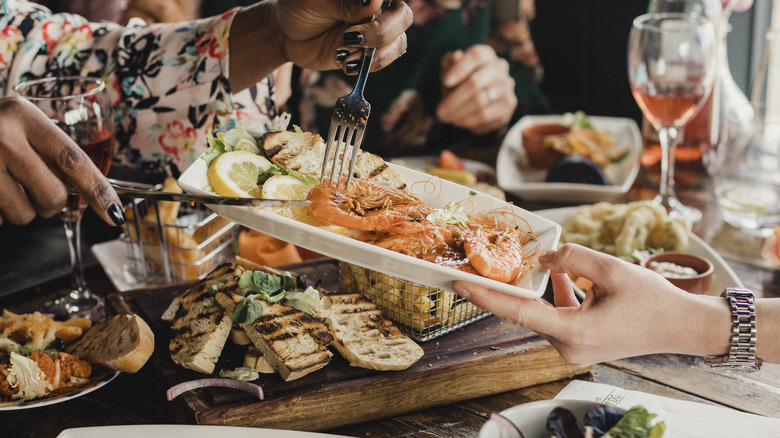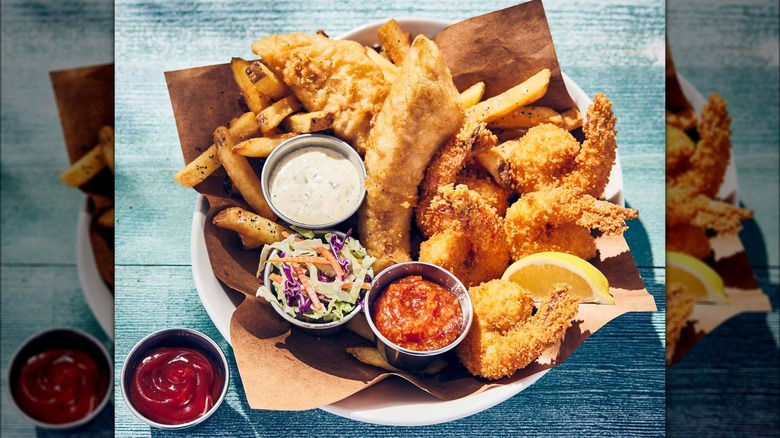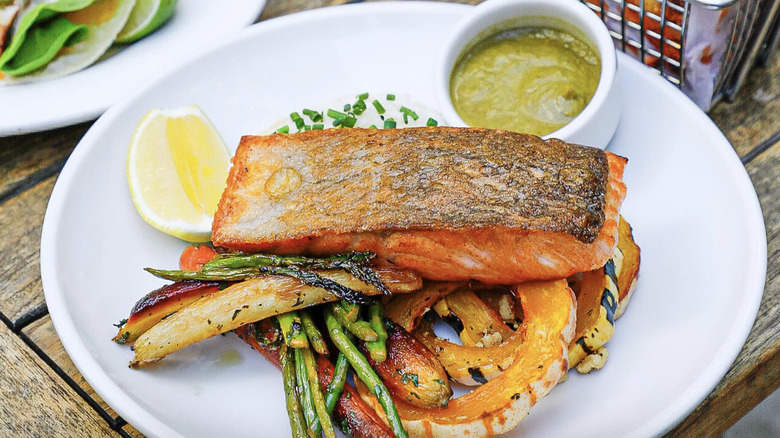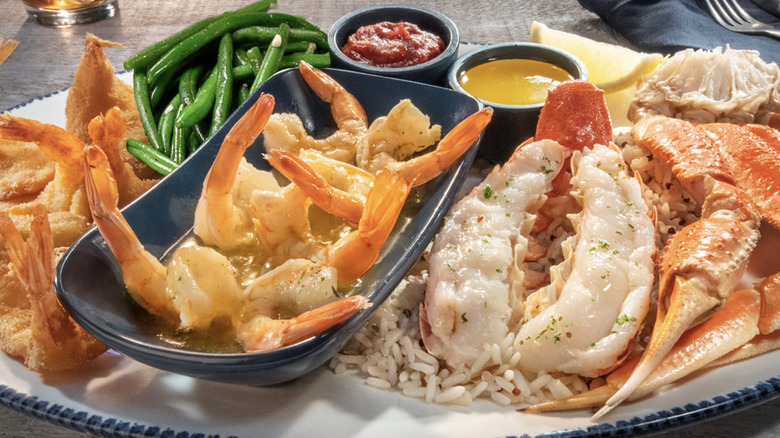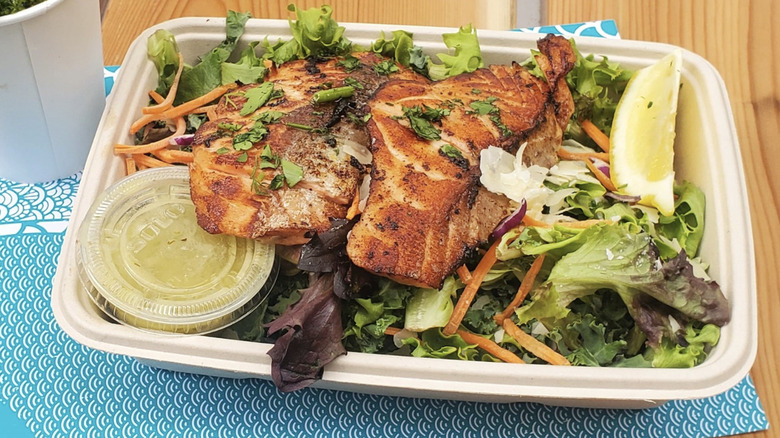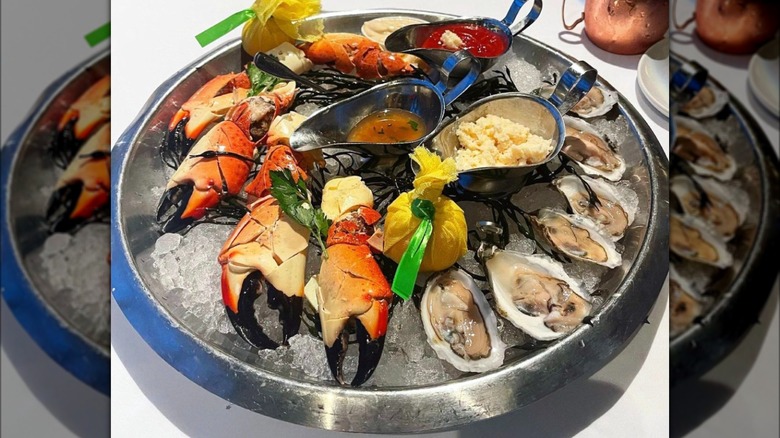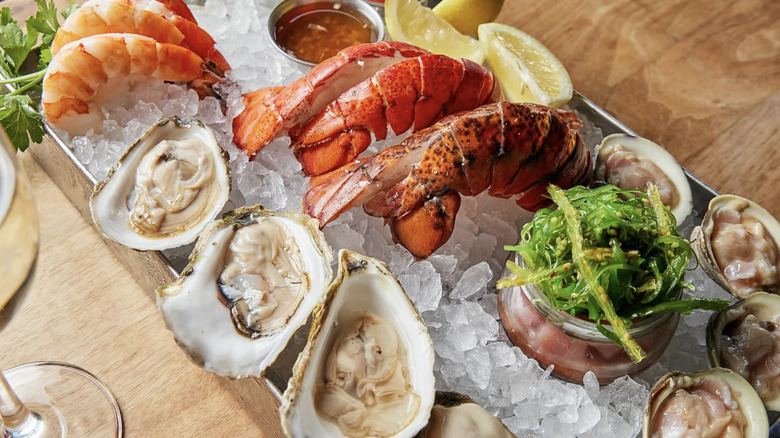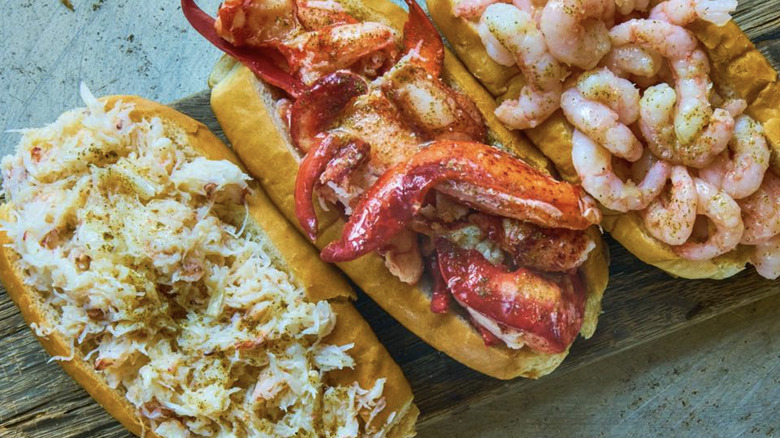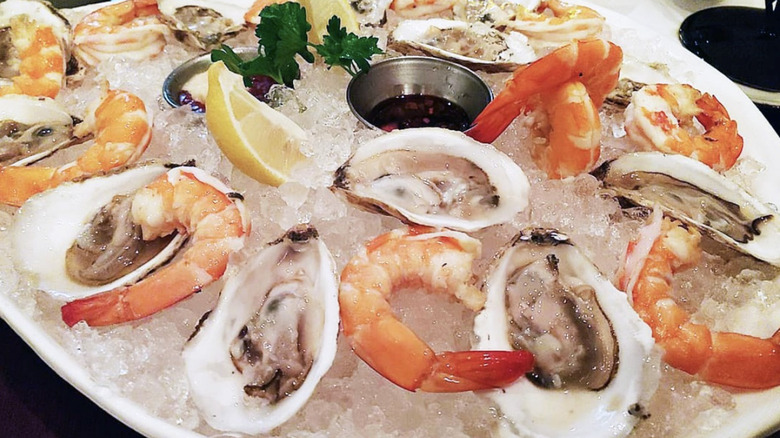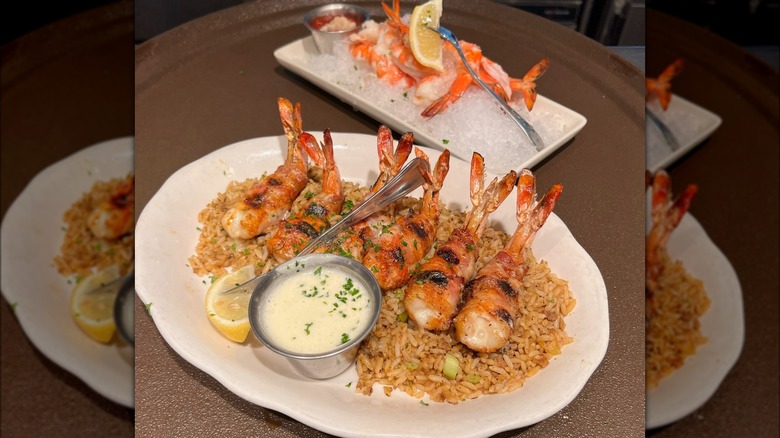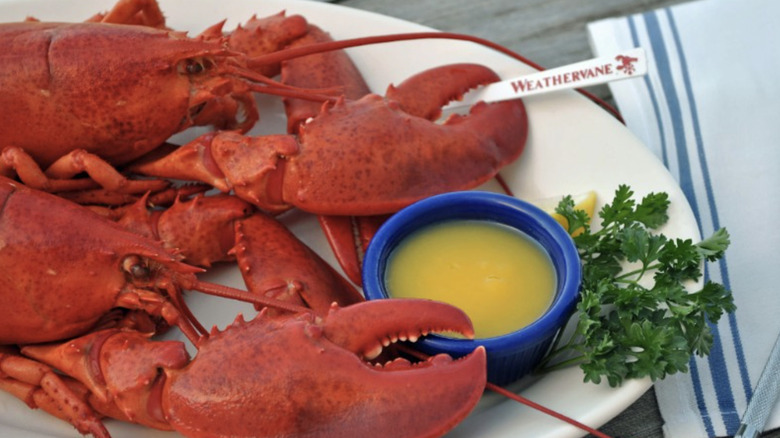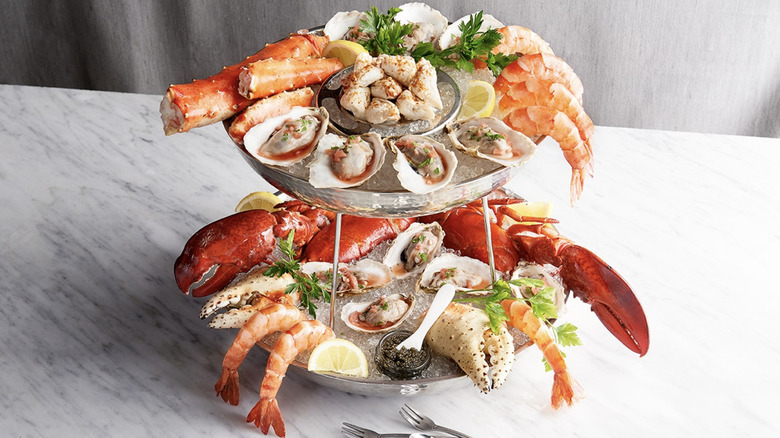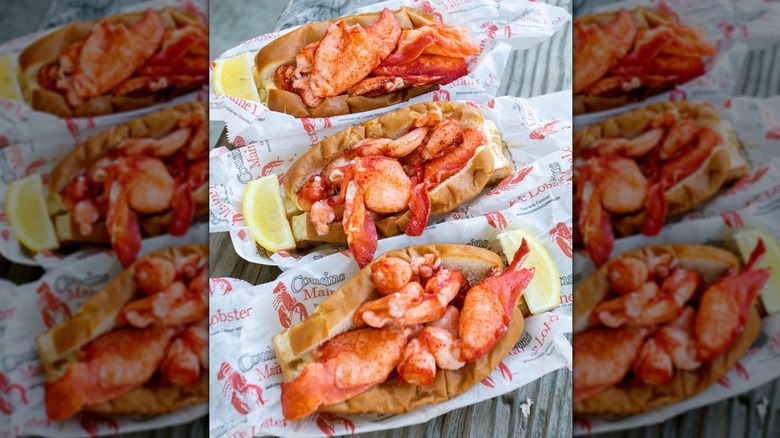Chains That Use The Highest Quality Seafood
From the succulent texture of tuna to the subtle flavors of crab and lobster, seafood can be turned into a hearty home-cooked feast or a centerpiece of a lavish restaurant dinner. Ultra versatile, aquatic delicacies can be grilled, steamed, battered and fried, and even chilled and served over ice. However, seafood isn't just enjoyed for its taste; it's also appreciated for its nutritional benefits. More specifically, fish and shellfish are rich sources of omega-3 fatty acids, vitamins, and minerals, as well as protein.
Chain restaurants differ in the caliber of the seafood offered. This isn't just a result of different preparation methods, but also due to the varying quality of the fish and shellfish itself. When it comes to seafood, freshness and origin matter. Seafood that is caught and served within a short timeframe often has superior flavor and texture. Moreover, sustainable fishing practices ensure the long-term health of marine ecosystems, adding another important consideration to your dining experience. To help you plan your next seafood dining adventure, we have compiled a list of the top chain restaurants based on the freshness, sustainability, and overall taste of the marine offerings. Check it out!
Bonefish Grill
According to Bonefish Grill's philosophy, the beginnings of a great meal can be found in the ocean. When opening the first restaurant in Florida, the chain's founders, Chris Parker and Tim Curci, found inspiration in their passion for reeling in and preparing fish. Today, Bonefish Grill continues to serve the freshest catches of the day. And the quality shows. Carolina Gazal, who reviewed Bonefish Grill, for Insider was impressed by the chain's signature Bang Bang Shrimp, describing them as large, tangy, and slightly browned. Just a Guy with an Appetite agrees with this assessment, calling the restaurant's shrimp "plump and tender," the crab "juicy," the salmon "tremendous and moist," and the tilapia "slightly firm [and] flaky."
So, what makes Bonefish Grill's ocean bounty stand out from the pack? To sum things up, the chain cares about the origins of its seafood. Firstly, the restaurant sources its produce locally, whenever possible, focusing on seasonal bounty to ensure maximum freshness. Secondly, Bonefish Grill emphasizes environmentally friendly practices. To ensure that its seafood is sustainable, the chain follows the guidelines set by the National Oceanic and Atmospheric Administration (NOAA) and all applicable government regulations. Bonefish Grill also supports The Nature Conservancy, an organization that aims to restore one million corals by 2025.
Seamore's
Just like its name suggests, Seamore's specializes in seafood dishes. The chain's menu abounds with marine delicacies, such as East Coast oysters, Maine lobster, and Montauk scallops. The chain's menu also features a daily "Fresh of the Dock" section with specialties such as oysters of the day and daily catches. To ensure that you get the freshest seafood possible, the restaurant features a blackboard with drawings and names of the fish that it offers. The ones marked with a red spoon are available on each given day. Seamore's Chef Laurence Cohen explained the philosophy behind the chain's practices to the Northern Virginia Magazine saying, "If Fisherman Carl says he has 200 pounds of snakehead he caught with a bow and arrow, we try to take as much of that as we can."
Not just delicious and fresh, the seafood offered at Seamore's is caught using responsible fishing practices. In addition, the produce is sourced locally whenever possible to both reduce carbon emissions and ensure that your dinner is as fresh as possible. To guarantee that its seafood only comes from the best sources, Seamore's follows the Monterey Bay Seafood Watch Standards, ensuring that its aquatic produce only comes from suppliers whose catch is rated either "best choice" or "good alternative."
Red Lobster
Starting with one Florida restaurant in 1968, over the years Red Lobster has grown from strength to strength. Today, the chain boasts more than 700 restaurants across the U.S. And there's a great reason why Red Lobster has done so well — the restaurant serves high-quality, well-prepared seafood. From grilled rainbow trout and wild-caught flounder to classics like Maine lobster and hand-breaded calamari, the Red Lobster menu is packed with a variety of delicious dinner options. In fact, a Mashed survey revealed that 34.36% of 649 diners believe that Red Lobster has the best quality seafood.
Those who care about where their meals come from will be pleased to know that Red Lobster only obtains its fish and shellfish from traceable, sustainable, and responsible sources. To do this, the restaurant builds long-term relationships with suppliers that follow the best industry practices set by organizations such as the Global Sustainable Seafood Initiative and Best Aquaculture Practices. Red Lobster also promotes healthy stewardship of marine resources through the adherence to standards set by Total Allowable Catch and other relevant regulations.
Brown Bag Seafood Co.
Practical and environmentally conscious, the humble brown paper bag holds a special place in the world of seafood. The unassuming packaging has been a staple in seafood markets and shops for many years, trusted for its ability to absorb moisture and keep seafood fresh. As such, the Brown Bag Seafood Co. name makes a lot of sense.
With 17 locations in Georgia, Illinois, and North Carolina, Brown Bag Seafood Co. offers a varied menu with an emphasis on sustainable and responsibly sourced seafood. The dishes feature fresh fish and shrimp creatively prepared and served with a variety of healthy sides like seasoned rice, fresh vegetables, and salads. When it comes to its marine fare, the restaurant only sources seafood caught in line with the regulations set by the Monterey Bay Seafood Watch to limit the risk of depleting marine populations. Some of the chain's other eco-friendly initiatives include powering its locations with wind energy, using energy-efficient equipment, and opting for green packaging — hello brown paper bag!
Truluck's
When Truluck's opened its first location in Houston in 1992, the Florida Stone Crab was relatively unknown in Texas, a state renowned for its Blue Crab. Today, the chain still serves sweet and meaty Stone Crab claws at its 12 locations across Texas, Florida, Illinois, and Washington, D.C. Truluck's' dishes out around 200,000 pounds of Florida Stone Crab claws annually during the crab season, which runs from October 15 to May 1. However, it does not offer shellfish outside this period. Truluck's practices sustainable harvesting by not killing crabs, which are returned to the ocean to regenerate after the removal of one claw.
Truluck's showed a strong commitment to sourcing its seafood with integrity right from the get-go. Shortly after opening its doors three decades ago, the chain started building partnerships with Florida crabbers and even invested in its own fishery. Today, Truluck's remains committed to sustainable harvesting methods by following the guidelines set by the Ocean Conservancy.
Truluck's has received its fair share of praise from satisfied diners, who compliment the chain for both the quality of its seafood and great service. One reviewer on Tripadvisor says that Truluck's offers the best seafood in Texas, adding, "I loved the stone crab. [...] The miso glazed fish was superb." Another happy diner on OpenTable mirrors this sentiment, elaborating, "And then there is the food. Austin is a long way from Maine or South Africa or Australia, but Truluck's has the best lobster one can find in this state."
Legal Sea Foods
Legal Sea Foods' commitment to high-quality, fresh seafood is unsurprising, given that the chain started as a seafood market. Established way back in 1950 in Cambridge, Massachusetts, this fish market was the precursor to the first Legal Sea Foods restaurant, which opened in 1968. At the time, diners would simply order their seafood broiled or fried and eat it from disposable plates at shared tables. Interestingly, one of these diners — known for ordering the restaurant's steamed lobster and clam chowder — was the famous chef and television personality Julia Child.
With the motto "If it isn't fresh, it isn't Legal!," today Legal Sea Foods continues to serve premium fish and shellfish at its 26 locations. The restaurant specializes in cold-water fish, categorized as either "top of catch" (caught right before docking), or sourced from day boat fishermen who go out to sea and return the same day. Legal Sea Foods also has set up a food safety laboratory where it examines all of its ocean bounty to ensure that its seafood is of the highest quality.
It's never been easier to enjoy Legal Sea Foods' top-notch fare. In 2023, the brand unveiled a new online shop where seafood enthusiasts can order a variety of the chain's favorite dishes. Some of these include New England Clam Chowder, Boston's Best Lobster Roll Kit, Colossal Naked Shrimp, and the Lobstah Lovers Box.
Luke's Lobster
The idea for Luke's Lobster was born after its co-founder, Luke Holden, failed to satisfy his lobster roll craving. A Maine native, Holden had recently moved to New York City and was surprised to find no reasonably priced, high-quality lobster rolls like those he was used to back home. Taking matters into his own hands, Holden opened the first Luke's Lobster in 2009 in New York City and the rest, as they say, is history. As a third-generation lobsterman, Holden eventually established his own seafood procurement company in Saco, Maine, which enabled him to directly control the quality of his seafood.
Today, Luke's Lobster shacks can be found in 12 U.S. states, as well as Singapore and Japan. One of the rolls on the chain's menu is the chilled lobster claw and knuckle meat roll. The restaurant also serves crab rolls with Jonah Crab meat and chilled shrimp rolls. Some other seafood delicacies on Luke's Lobster shack's menu include the Steamed Lobster Platter, Golden Calamari, Steamed Mussels, and Fried Clams. All of the chain's seafood is locally obtained from producers who sustainably harvest their catch from the coastal waters of Maine and Canada.
McCormick & Schmick's
With around 25 locations across the U.S., McCormick & Schmick's has been serving quality seafood since first opening its doors in 1974. The upscale seafood chain offers a menu jam-packed with premium offerings such as Buttermilk Fried Shrimp, Seared Ahi Tuna, Pan Seared Chilean Sea Bass, and Crab and Shrimp Stuffed Salmon.
At McCormick & Schmick's, the emphasis extends beyond just flavor to include a deep commitment to sustainability. This restaurant prides itself on preparing meals with ingredients obtained through eco-friendly means, emphasizing the importance of ethical fishing practices that contribute to ocean conservation. The chain's menu, for example, features ahi tuna sourced through longline fishing techniques on U.S.-flagged vessels, as well as responsibly-raised salmon. The oysters are another highlight, coming from proprietary oyster beds and harvested using restorative farming techniques.
Aside from seasonal fish such as Northwest Salmon, Alaskan Halibut, and Oregon Petrale Sole, McCormick & Schmick's also serves Open Blue Cobia. Billing its cobia as one of the most sustainably-raised fish available, Open Blue farms have a minimal to no impact on the surrounding marine environment, demonstrating the company's commitment to ecological conservation.
Pappadeaux Seafood Kitchen
Pappadeaux Seafood Kitchen has some pretty interesting dishes on the menu. Alongside classics such as Oven-Baked Crab Cakes and Fried Shrimp, the chain also serves plates such as crispy alligator and shrimp and crawfish fondeaux. There are also Cajun specialties such as Blackened Catfish and Jumbo Shrimp Brochette.
Owned by the same family since its establishment in 1976, Pappadeaux boasts over 30 locations across the U.S. In fact, over the years, the Pappas family has built quite an empire that encompasses restaurants such as Pappasito's Cantina, Pappas Bros. Steakhouse, Pappas Bar-B-Q, and Pappas Burger. And to ensure that only the freshest bounty reaches its kitchens, the restaurant owns a fleet of trucks that deliver the best seafood right from the docks to its kitchens on a daily basis. Additionally, Pappadeaux isn't afraid of changing its menu depending on what is seasonally available.
Diners seem to appreciate the effort the Pappas family puts into procuring and preparing its seafood. For instance, one satisfied reviewer on Yelp praises the restaurant saying, "Consistently delicious. I personally find that the pricing suits the quality of the meal and I never fail to leave happy! Big portion sizes! The grilled tilapia with lump crab was savory and delicious [and] served with huge shrimp." Another customer on Tripadvisor agrees saying, "The Mississippi catfish and shrimp were the best I have ever had, and I've eaten in New Orleans many times." Enough said!
Weathervane Seafood Restaurants
Weathervane Seafood Restaurants is a small family-operated chain founded by Ray and Bea Gagner in 1969. Unlike many similar operations, the chain hasn't grown into hundreds of outlets. Instead, Weathervane has maintained a smaller footprint, operating just five locations — one in Maine and four in New Hampshire. Despite its small scale, Weathervane serves a lot of seafood. More specifically, each year the restaurant chain dishes out 275,000 to 300,000 pounds of Maine lobster, 60,000 pounds of clams, and 38,000 pounds of scallops.
According to Weathervane's director of procurement, Jim Collins, the chain is able to obtain high-quality seafood due to the relationships it has built with local fishermen throughout New England. When it comes to sourcing fresh bounty, attention to detail is also important. "You have to know when the seasons start and what the quotas look like and you have to anticipate and watch as the season goes on," Collins explains (via Weathervane Seafoods).
The Oceanaire Seafood Room
From Responsibly Sourced Salmon brushed with lemon butter to one-pound Premium Red King Crab, The Oceanaire Seafood Room has been serving fresh aquatic produce since it opened its first location in Minneapolis in 1998. Sourced from reputable producers from around the globe, The Oceanaire's seafood is flown in daily to ensure maximum freshness.
Rather than keeping its dining options static, The Oceanaire Seafood Room changes its menu on a regular basis — sometimes as often as twice a day — to reflect the latest delivery of seafood. The vice president of culinary development for Landry's Inc., a hospitality group behind the Oceanaire, explained the chain's sourcing philosophy in an interview with USA Today saying, "Our executive chefs and seafood experts are leading the way by making a commitment to limiting at-risk species on its menu. Restaurants and seafood is our livelihood, so we have to make sure we are being respectful to the ocean's health."
The Oceanaire's strategy seems to be working, with online reviewers praising the establishment for the quality of its fare. One diner on Tripadvisor, for instance, describes their experience at the restaurant as "dining at its best," adding, "When in Boston, you gotta have the usual, Lobster tail. We started off with some very tasty oyster baked with bacon. Then [I] paired it with white wine and the dinner was just superb!"
Cousins Maine Lobster
True to its name, Cousins Maine Lobster is all about serving delicious takes on Maine lobster. From lobster tacos and quesadillas to lobster tots and rolls, the chain appeals to both lovers of classic seafood and those looking for a unique culinary experience. Rather than focusing on just brick-and-mortar restaurants, Cousins Maine Lobster also has a fleet of trucks stationed around the country. In addition, the chain also offers an online store where shellfish enthusiasts can order lobster and crab dishes to enjoy in the comfort of their own homes.
Keenly aware of the importance of conservancy, Cousins Maine Lobster is very specific about the shellfish it offers. The chain only serves lobsters between 3.25 and 5 inches. Lobsters smaller than this size range are released back into the ocean to give them time to grow further. Similarly, larger lobsters are also returned to their natural habitat to ensure that they can continue breeding. In addition, each new franchisee receives training in Maine where they get the chance to join lobstermen on their boats, bait and haul traps, and learn how to measure their catch to ensure adherence with sustainable practices.
